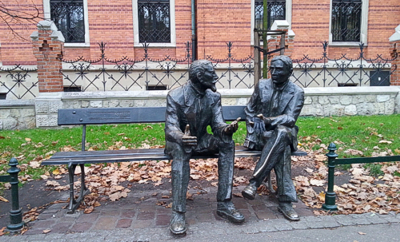|

Mathematicians bench
in the
Krakow
Planty gardens.
Krakow’s central Planty ring of
gardens, surrounding the Old Town historic district, have many
benches but one of them is very special. Situated at the foot of
the Wawel Hill beneath the Royal Castle and the Krakow
Cathedral, in front of the redbrick neo-Gothic building of a
seminary, it’s occupied 24/7. Two gesticulating men seated
permanently on the wooden bench appear lost in an eternal
dispute. They probably wouldn’t notice you even if they weren’t
made of bronze.
Many benches of the Planty
gardens commemorate writers, Polish and foreign, with metal
plates screwed to backrests, befitting the fact that Krakow
has been named the UNESCO City of Literature in 2013. Yet
the pair of bronzes near the Wawel Royal Castle honor two
outstanding Polish mathematicians of the 20th century,
Stefan Banach and Otto M. Nikodym. Krakow’s park-bench
memorial to them was erected on October 14th, 2016 and has immediately
become popular with the residents and tourists alike.
Actually, it commemorates the centenary of one wartime
evening in 1916 when mathematician Hugo Steinhaus, strolling
in Planty gardens, overheard two young people discussing
abstract mathematics. He joined them and shared a math
problem which bothered him for some time, so much to his
surprise a few days later the younger of his new
acquaintances, Stefan Banach, then 24,
called upon him and provided the solution.
Krakow is a math stronghold,
Soon after the rebirth of
independent Poland, Steinhaus and Banach moved to Lwow in
the eastern half of the country (now the city of Lviv in
western Ukraine) where they would become the pillars of the
famous Lwow school of mathematics. Nevertheless “the
Mathematicians bench” in the Planty gardens is also a
memorial to the Krakow traditions of mathematics.
Soon after its re-establishment
in 1400, the Krakow University (Jagiellonian) became the
leading center of mathematics in Europe, i.e. in the world.
Also in the 20th century and presently the Jagiellonian
University has been a beacon in the realm of the queen of
all sciences. In the interwar period (1918 to 1939) a group
of Krakow mathematicians - Stanislaw Zaremba, Tadeusz
Wazewski, and Franciszek Leja among others - called the Krakow school of
mathematics, made a name for themselves primarily in such
areas as classical analysis, differential equations, and
analytic functions.
Also renowned astronomer Tadeusz Banachiewicz
(born 1882, died 1954) a professor at the
Krakow University, made a name for himself internationally
as a mathematician. Banachiewicz has introduced a new kind of matrix
algebra he named “cracovians” to honor his city.
In recognition of his diverse achievements he got a
lunar crater Banachiewicz and an asteroid 1286 Banachiewicz
named after himself.
|
Krakow Planty
Gardens
Krakow's Institutions of Higher Education
Schools in Krakow
Jagiellonian Library
Poland's oldest library boasts 4.5 million volumes and
its unique collection of medieval manuscripts and ancient
books contains tens of thousands priceless items.
Krakow University
Poland’s oldest university with Poland’s oldest university with its 6,700 faculty and
over 42,000 students is the country’s second largest institution
of higher education and the best one.
Krakow Old Town Historical
District
Poland's prime tourist attraction and a must-see in
Central Europe boasts numerous world-class monuments, charming
vistas, delightful atmosphere, and the best restaurants.
|



